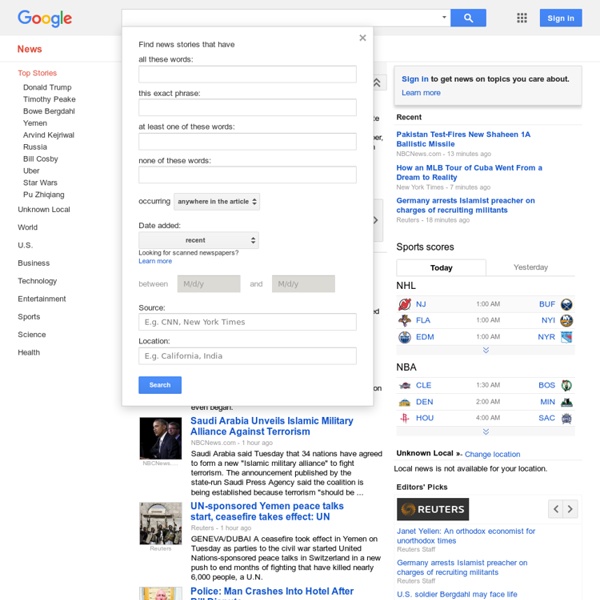



http://news.google.com/news/advanced_news_search?as_drrb=a
Google Genealogy Style - Google Power Search Tips for Genealogists Google is the search engine of choice for most genealogists I know, due to its ability to return relevant search results for genealogy and surname queries and its huge index. Google is much more than just a tool for finding Web sites, however, and most people surfing for information on their ancestors barely scratch the surface of its full potential. If you know what you are doing, you can use Google to search within Web sites, locate photos of your ancestors, bring back dead sites, and track down missing relatives. The Monthly Packet - Charlotte Mary Yonge "... one could say that this was one of the first teenage magazines that was ever written ..
Learn to Use Google in Genealogy Searches - Google Genealogy Tips Since the Google search engine went live in September 1999, it has changed the way people search the web. Today, many genealogists use Google for their genealogy internet and surname queries, and for good reason. Not only does Google produce accurate and relevant search results, Google is extraordinarily fast and flexible. VICTORIAN PERIODICALS [Return to VRW] Tenth edition: July 2010 (First published, 1999) Prepared by Rosemary T. Reading Experience Database - Home Reading is not confined by national borders: readers travel, and books circulate internationally. But how can we trace the evidence of reading across borders? Are authors famous in one country equally admired by readers elsewhere? Search or browse our databases to find out… RED is a collection of databases whose aim is to accumulate as much evidence as possible about reading experiences across the world. The search and browse facilities enable you to chart the reading tastes of individual readers as they travel to other countries, and consider how different environments may have affected their reading.
About The Nineteenth Century - Children's Literature Nineteenth Century Children's Literature Edited by J. Barr Welcome to Dime Novels Stanford's Dime Novel and Story Paper Collection consists of over 8,000 individual items, and includes long runs of the major dime novel series (Frank Leslie's Boys of America, Happy Days, Beadle's New York Dime Library, etc.) and equally strong holdings of story papers like the New York Ledger and Saturday Night. Both genres flourished from the middle to the close of the 19th century in America and England (where the novels were known as "penny dreadfuls"), and benefited from three mutually reinforcing trends: the vastly increased mechanization of printing, the growth of efficient rail and canal shipping, and ever-growing rates of literacy. The dime novels were aimed at youthful, working-class audiences and distributed in massive editions at newsstands and dry goods stores.
English Listening Online Views: Biking in Cambodia Julia talks about cycing from Cambodia to Vietnam with her friends (Part 1, Part 2, Part 3, Part 4). Mixers : Bad Hair Cut Six people talk about getting a bad haircut. Plus, be sure to check out all the re-edited mixers with new activities 1-25, 26-50, 51-75, 76-100. New Videos for Mixer Listen to over 20 new videos with new speakers from Chile, Argentina, Canada, the U.S. and more. Scenes: Erina in Vancouver Listen as the series ends with Erina starting her new job at Campus Pizza Scene #6 and Scene #7. Brontë Sources, Texts, and Criticism search [Rigby, Elizabeth.] "Vanity Fair--and Jane Eyre." TeachingEnglish Upload TeachingEnglish Subscription preferences Loading... Working... British Council | TeachingEnglish Godey's Lady's Book: Hope Greenberg In the February 1850 issue of The Lady's Book, Louis A. Godey, publisher, declared: "In 1830, a "magazine of elegant literature was cast, doubtingly, upon the uncertain stream of public favor--its name the Lady's Book and Louis A. Godey the publisher.
Greenberg: Godey's Lady's Book - Fashion, Patterns Godey's Lady's Book The beginning of each issue of the Book in the period 1855-1858 contained a hand-tinted engraving of current fashions. This was followed by several pages that included engravings to illustrate stories and engravings of other fashionable items such as hats, shawls, etc. There were also several pages of "work": embroidery patterns, slipper patters, etc. At the end of each issue was a section devoted to more patterns.
Modaux : Can, could and be able to Can, could, be able to We use can to say that something is possible or that somebody has the ability to do something. We use can + infinitive (can do / can see etc.